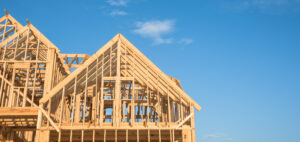 The U.S. Census Bureau and the U.S. Department of Housing and Urban Development (HUD) have jointly issued their new residential construction statistics for November 2023, which found that privately‐owned housing starts in November 2023 were at a seasonally adjusted annual rate of 1,560,000, which was 14.8% above the revised October 2023 estimate of 1,359,000, and 9.3% above the November 2022 rate of 1,427,000. Single‐family housing starts in November were at a rate of 1,143,000—18% above the revised October figure of 969,000. The November rate for units in buildings with five units or more was 404,000.
The U.S. Census Bureau and the U.S. Department of Housing and Urban Development (HUD) have jointly issued their new residential construction statistics for November 2023, which found that privately‐owned housing starts in November 2023 were at a seasonally adjusted annual rate of 1,560,000, which was 14.8% above the revised October 2023 estimate of 1,359,000, and 9.3% above the November 2022 rate of 1,427,000. Single‐family housing starts in November were at a rate of 1,143,000—18% above the revised October figure of 969,000. The November rate for units in buildings with five units or more was 404,000.
“Homebuilder sentiment ended the year on a more positive note, increasing for the first time in five months,” said First American Deputy Chief Economist Odeta Kushi. “Falling mortgage rates led to a pickup in prospective buyer traffic and sales expectations.”
HUD and the Census Department also found that privately‐owned housing units authorized by building permits in November 2023 were at a seasonally adjusted annual rate of 1,460,000, 2.5% below the revised October 2023 rate of 1,498,000, but 4.1% above the November 2022 rate of 1,402,000.
Single‐family authorizations in November were at a rate of 976,000—0.7% above the revised October figure of 969,000. Authorizations of units in buildings with five units or more were at a rate of 435,000 in November.
“Despite all the apartments and homes under construction, the U.S. housing market remains meaningfully underbuilt,” added Kushi. “Estimates of the nationwide housing shortage vary, but tend to range from between 3.5 million to 5.5 million housing units. This implies that, even if all the apartments and homes currently under construction came to market tomorrow, we’d still be underbuilt by millions of units. In other words, the new supply of housing coming to market is more likely to ease, rather than erase, the national housing shortage, although this will vary by location.”

In terms of easing that supply shortage, HUD and the Census Bureau reported that privately‐owned housing completions in November 2023 were at a seasonally adjusted annual rate of 1,447,000, 5.0% above the revised October estimate of 1,378,000, but 6.2% below the November 2022 rate of 1,543,000. Single‐family housing completions in November were at a rate of 960,000—3.2% below the revised October rate of 992,000. The November rate for units in buildings with five units or more was 472,000.
“There are currently 680,000 single-family homes under construction, which is down 18% from the peak in spring 2022. In contrast, there are nearly one million apartments under construction, down just 1.3% from the peak reached earlier this year,” noted Kushi. “Multi-family completions picked up nearly 27% on a month-over-month basis in November. This new supply will put downward pressure on rents, and there is more to come given all the multi-family units under construction.”
As 2023 closed out, Freddie Mac reported continued relief for prospective buyers in the form of the 30-year, fixed-rate mortgage, which closed out 2023 at 6.67%, finally dipping below the 7% mark after 17 consecutive weeks above 7%.
As Sam Khater, Freddie Mac’s Chief Economist, noted, “Lower rates are bringing potential home buyers who were previously waiting on the sidelines back into the market and builders already are starting to feel the positive effects. A rise in home builder confidence, followed by new home construction reaching its highest level since May, signals a response to meet heightened demand as current inventory remains low.”
Builder confidence has taken a turn for the better, as the latest National Association of Home Builders (NAHB)/Wells Fargo Housing Market Index (HMI) found that the recent slide in mortgage rates has helped end a four-month decline in builder confidence, along with recent economic data signal improving housing conditions heading into the new year. The Index found builder confidence in the market for newly built single-family homes rose three points to 37 in December, reversing the trend of the previous four months.
“With mortgage rates down roughly 50 basis points over the past month, builders are reporting an uptick in traffic as some prospective buyers who previously felt priced out of the market are taking a second look,” said NAHB Chairman Alicia Huey. “With the nation facing a considerable housing shortage, boosting new home production is the best way to ease the affordability crisis, expand housing inventory, and lower inflation.”
CoreLogic Chief Economist Dr. Selma Hepp added, “While housing starts have been dragging, the improved outlook for 2024 reflects expectations that lower mortgage rates will boost builder confidence and potentially lead to more construction across the U.S. Lower mortgage rates will also help improve affordability, which has fallen to some of the lowest levels in history.”

 theMReport.com Your trusted source for mortgage banking news
theMReport.com Your trusted source for mortgage banking news








